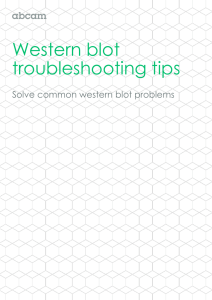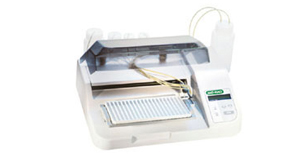
9 cm 2 petri dishes hold 5-10 mL and are convenient for washing and incubating mini-blots. After protein transfer, dried blotting membranes can be stored at room temperature for months to years prior to detection. In our experience, nitrocellulose and low fluorescence PVDF membranes show similar background fluorescence, but PVDF can give higher sensitivity, possibly due to higher protein binding. Either nitrocellulose or PVDF may be used for fluorescent western, but autofluorescence can vary widely among different sources of blotting membrane. Blue tracking dyes in SDS-PAGE loading buffer can fluoresce in the far-red/near-infrared spectra loading buffer with an orange tracking dye is recommended for fluorescent western detection. Optimal protein loading amount varies depending on detection method and target expression level, but ranges between 1-10 ug/lane for most applications. Visible fluorescent dyes can be used, but generally will have lower signal-to-noise ratio due to higher autofluorescence of proteins and blotting membranes in the visible spectrum. Far-red or near-infrared dyes are optimal for fluorescent western, because background is lower in these wavelengths. For best results, use a gel imager or scanner specifically designed for imaging fluorescent blots. Multiplex fluorescence western detection requires an imaging system capable of detecting multiple fluorescent conjugates. Discovery of DS-1971a, a Potent Selective NaV1.7 Inhibitor.General considerations for fluorescent western detection:. Use of DNA ladders for reproducible protein fractionation by sodium dodecyl sulfate-polyacrylamide gel electrophoresis (SDS-PAGE) for quantitative proteomics. Partial purification and characterization of chitinase produced by Bacillus licheniformis B307. Dataset on interactors of the Arabidopsis thaliana Plant Natriuretic Peptide (AtPNP-A) determined by mass spectrometry. Suppliers for Western Blot reagents for protein Electrophoresis also have a technical support them to assist you with the selection of the right tools.Įlectrophoresis first separates the proteins through an SDS-polycacrylamide gel and then the proteins are transferred electrophoretically from gel to membrane. Western blotting or Immunoblotting is used to determine the size and quantity of protein antigens which react with a specific antibody. Antibodies behave much differently however than nucleic acid probes. Whereas nucleic acids are used as probes in the other blotting techniques, western blotting uses antibodies to probe for target proteins of interest. The major difference between Western blotting and Northern / Southern blotting is the properties of the probes used in the detection of proteins. Western blotting can detect as little as 0.5 ng of protein an average sized protein in kDa. Western blotting is an important technique for the detection and quantification of proteins that are not radiolabeled. The antibodies react specifically with antigenic epitopes on the target protein which are attached to the PVDF or Nitrocellulose. Western blot uses antibodies which detect denaturated proteins. The membrane is then probed with factors which are specific for amino acids (western) or nucleotide (Southern and Northern) Polyclonal Antibodies for WB In all blot Protocols, samples are separated by SDS Page and are transferred from a gel to a membrane. Western blotting is to protein epitopes, as Southern blot is to cDNA, genomic DNA and RNA is to Northern blotting. 

Learn about Western Blotting with Rabbit or Goat Poly-clonal Antibodies Western Blot








